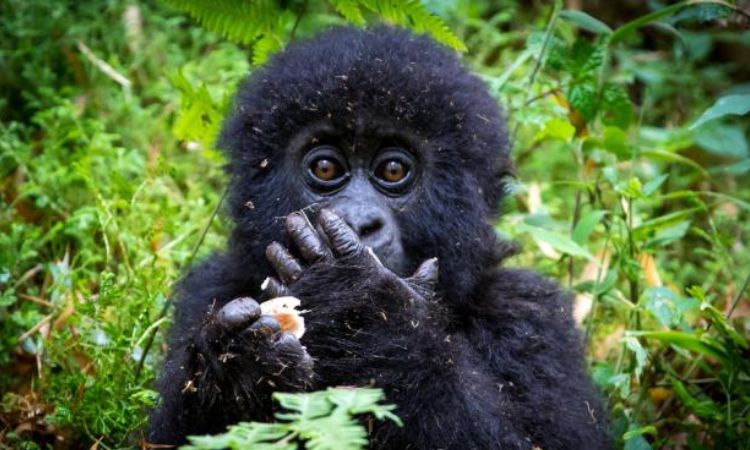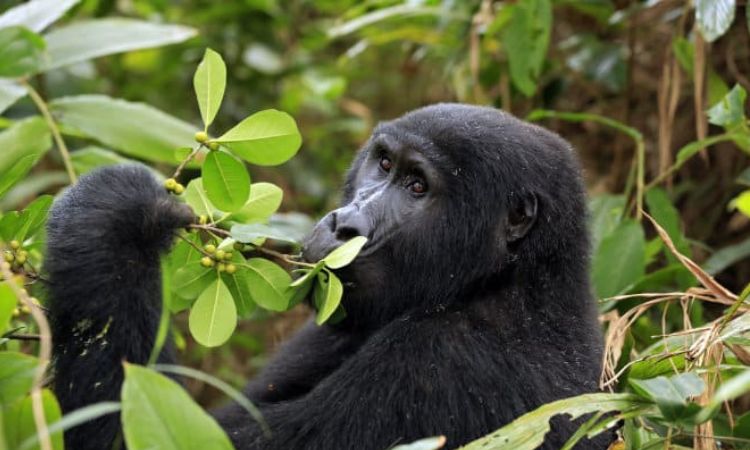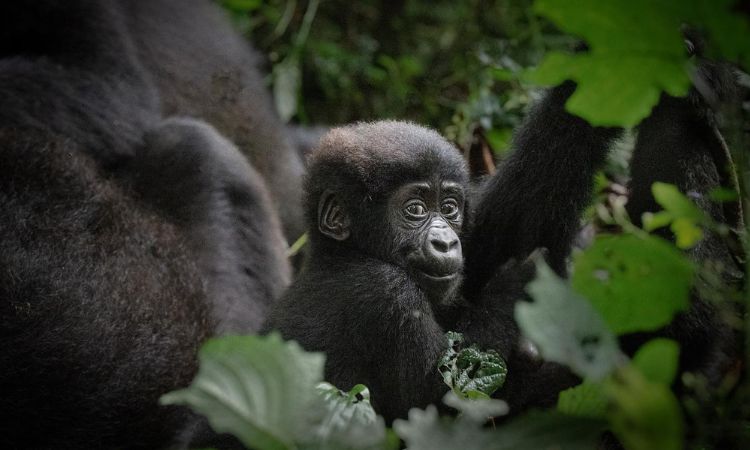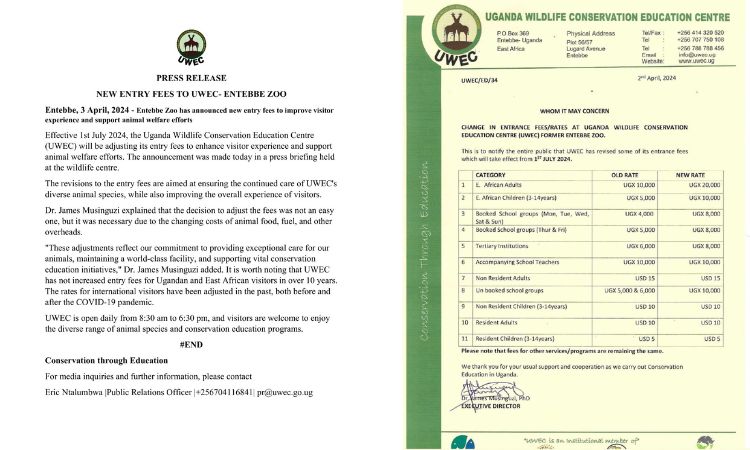What Do Gorillas Eat for Protein? Their Plant-Based Power
What Do Gorillas Eat for Protein: Learn how gorillas build strength on a plant-based diet. Discover the protein-rich foods that sustain these powerful primates.
Gorillas, the largest primates on Earth, are renowned for their immense strength and muscular builds. Yet, surprisingly, these powerful creatures are primarily herbivorous.
If gorillas don’t rely on meat, how do they get the protein needed to maintain their massive physiques? The answer lies in their plant-based diet, rich in protein-packed vegetation and occasional insects.
This ultimate guide explores the gorilla diet, focusing on how these primates source protein, how their bodies process it, and how their diet varies across species and environments.
From mountain gorillas in the misty highlands to lowland gorillas in dense rainforests, we’ll uncover the secrets behind their plant-powered strength.
Overview of a Gorilla’s Diet
Gorillas are predominantly herbivorous, consuming a diet that varies slightly depending on their species and habitat. Their daily menu consists of:
- Leaves and stems: These make up 60–70% of a gorilla’s diet, providing fiber, minerals, and protein.
- Fruits: Especially favored by lowland gorillas, fruits offer sugars, vitamins, and some protein.
- Shoots, bark, and roots: These fibrous foods are rich in minerals and aid digestion.
- Insects: Termites, ants, and larvae are eaten occasionally, contributing a small protein boost.
On average, an adult gorilla consumes 20–30 kg (44–66 lbs) of vegetation daily, spending up to six hours foraging and eating. This massive intake ensures they meet their nutritional needs, including protein, to fuel their active lifestyles and maintain their impressive physiques.

What Do Gorillas Eat for Protein?
Gorillas derive most of their protein from plant-based sources, with occasional supplementation from insects. Their digestive systems are uniquely adapted to extract nutrients from tough, fibrous vegetation, allowing them to thrive without meat.
Protein-Rich Plants Gorillas Eat
Gorillas consume a variety of plants that are surprisingly high in protein, supporting their muscle development and overall health. Key protein sources include:
- Leaves of wild celery, nettles, and thistles: These are rich in protein and essential amino acids like lysine, crucial for muscle repair and growth.
- Young bamboo shoots: Particularly favored by mountain gorillas, bamboo shoots contain high levels of methionine and other amino acids that support tissue development.
- Wild fruits: Figs, guavas, and other fruits provide small amounts of protein alongside vitamins and antioxidants.
- Seeds and nuts: Though consumed less frequently, these are nutrient-dense and offer additional protein and healthy fats.
These plants provide a balanced mix of amino acids, enabling gorillas to build and maintain their muscular bodies without relying on animal-based protein.
How Gorillas Get Protein from Plants
Gorillas extract protein from plants through a highly efficient digestive process. Their large stomachs and elongated intestines are designed to ferment tough plant matter.
Microbes in their gut break down cellulose, a complex carbohydrate found in leaves and stems, releasing amino acids and fatty acids.
This fermentation process mimics the energy and nutrient release seen in meat-based diets, allowing gorillas to derive sufficient protein from plants.
For example, the high fiber content in leaves is broken down into volatile fatty acids, which provide energy, while amino acids from plant proteins support muscle growth.
Insects and Ants as Additional Protein Sources
While plants dominate their diet, some gorilla species, particularly western lowland gorillas, occasionally eat insects like termites, ants, and larvae.
These provide a small but valuable source of animal-based protein, contributing less than 2% of their total diet. Eastern gorillas, including mountain gorillas, consume fewer insects due to their high-altitude habitats, where such food sources are less abundant. This minimal reliance on animal protein underscores the effectiveness of their plant-based diet.
How Do Gorillas Get So Muscular Without Meat?
Despite their herbivorous diet, gorillas are 4–9 times stronger than humans, raising the question: how do they build such impressive muscles without meat? The answer lies in a combination of their diet, physiology, and lifestyle:
- High-protein plant intake: A gorilla’s diet contains 17–20% protein, comparable to the intake of human athletes. For example, an adult gorilla consumes 400–500 grams of plant-based protein daily from leaves, shoots, and fruits.
- Efficient digestion: Their gut microbes break down fibrous plants, releasing amino acids that support muscle growth.
- Active lifestyle: Gorillas are constantly moving, climbing, and foraging, which naturally builds and maintains muscle mass.
- Genetic adaptations: Gorillas have evolved to maximize nutrient absorption from plants, allowing them to thrive on a diet that might seem insufficient for their size.
This combination enables gorillas to develop their powerful physiques without relying on meat or other animal-based proteins.
Comparison: Gorilla Protein vs. Human Protein Intake
Humans often turn to meat, dairy, or supplements to meet protein needs, while gorillas rely entirely on plants. A gorilla’s diet provides 17–20% protein, similar to what human athletes consume (1.2–2.0 grams of protein per kg of body weight).
For a 180 kg (400 lb) gorilla, this translates to 400–500 grams of protein daily, sourced entirely from vegetation. Unlike humans, who digest food quickly, gorillas’ slow digestion and fermentation process maximize nutrient absorption.
This comparison highlights the potential of plant-based diets to support strength and health, even for large, muscular mammals.
What Fruits Do Gorillas Eat?
Fruits are a significant part of a gorilla’s diet, particularly for western lowland gorillas. Common fruits include:
- Figs: Nutrient-dense and rich in small amounts of protein.
- Guavas: Provide vitamins and trace proteins.
- Berries: High in antioxidants and sugars for energy.
- Wild bananas: Contrary to popular belief, gorillas rarely eat cultivated bananas in the wild, but they may consume wild varieties with tougher skins.
Fruits make up a larger portion of the diet for lowland gorillas compared to mountain gorillas, who rely more heavily on leaves and shoots due to the scarcity of fruit in highland habitats.
Do Gorillas Eat Bananas, Fish, or Monkeys?
- Do gorillas eat bananas? In the wild, gorillas rarely eat the cultivated bananas we know. They may consume wild bananas, which are smaller and seed-filled, but these are not a staple. In zoos, bananas are sometimes offered as treats but are not a primary food.
- Do gorillas eat fish? Gorillas are not known to eat fish in the wild. Their diet is almost entirely plant-based, with occasional insects, and fish are not part of their natural food sources.
- Do gorillas eat monkeys? No, gorillas do not eat monkeys. They are herbivorous and do not prey on other animals, including monkeys, even in shared habitats.
Differences Between Gorilla Species
Gorilla diets vary by species and habitat, reflecting the diversity of their environments:
|
Gorilla Species |
Protein Sources |
Habitat |
|
Mountain Gorilla |
Leaves, stems, bamboo shoots |
Bwindi & Virunga highlands |
|
Western Lowland Gorilla |
Fruits, seeds, ants, termites |
Central & West Africa rainforests |
|
Eastern Lowland Gorilla |
Roots, leaves, occasional insects |
Congo Basin forests |
|
Cross River Gorilla |
Fruits, leaves, nuts |
Nigeria-Cameroon forests |
Mountain gorillas, for example, rely heavily on fibrous plants like bamboo due to their high-altitude environments, while western lowland gorillas have access to a wider variety of fruits and insects in rainforests.

How Much Do Gorillas Eat a Day?
An adult gorilla consumes 20–30 kg (44–66 lbs) of vegetation daily, depending on its size and species. This includes:
- 12–20 kg of leaves and stems.
- 5–10 kg of fruits (for lowland gorillas).
- 2–5 kg of shoots, bark, and roots.
- Small amounts of insects (less than 0.5 kg).
This massive intake provides 400–500 grams of protein, along with carbohydrates, fiber, and micronutrients, ensuring gorillas meet their energy and muscle-building needs.
What Do Gorillas Eat in the Zoo?
In zoos and sanctuaries, caretakers replicate wild gorilla diets to ensure proper nutrition. A typical zoo diet includes:
- Leafy greens: Kale, spinach, and lettuce mimic wild leaves.
- Fruits: Apples, bananas, and oranges are offered, though in moderation to avoid excess sugar.
- Vegetables: Carrots, sweet potatoes, and celery provide variety.
- Legumes and shoots: Beans and alfalfa sprouts offer protein and fiber.
- Specialized pellets: These are formulated to provide balanced nutrients.
Facilities like the Karisoke Research Center and zoos worldwide prioritize diets that mirror natural foraging patterns to support gorilla health and rehabilitation.
Conservation and Feeding in Sanctuaries
In sanctuaries like Bwindi Impenetrable National Park and the Dian Fossey Gorilla Fund, feeding programs are critical for gorilla conservation.
These programs replicate wild diets by providing native plants, fruits, and shoots, ensuring rehabilitated or orphaned gorillas receive adequate nutrition.
Proper diet supports their physical health and prepares them for potential reintroduction to the wild. Conservation efforts also protect gorilla habitats, ensuring access to their natural food sources.
Fun Facts About Gorilla Diets
- Gorillas rarely drink water, getting most of their hydration from juicy plants.
- They spend over 6 hours a day foraging and eating.
- Bamboo shoots and wild celery are among their favorite snacks.
- Despite being herbivores, gorillas are 4–9 times stronger than humans.
FAQs About Gorilla Diets
Do gorillas eat meat for protein?
No, gorillas are primarily herbivorous, relying on plants for protein, with occasional insects like termites providing a small boost.
How do gorillas get so strong if they don’t eat meat?
Their plant-based diet provides 17–20% protein, and their efficient digestion, active lifestyle, and genetics enable muscle growth.
What is a gorilla’s favorite food?
Gorillas love bamboo shoots, wild celery, and fruits like figs, depending on their species and habitat.
Do gorillas eat bananas in the wild?
They may eat wild bananas, but cultivated bananas are not a staple in their natural diet.
What nutrients do gorillas get from plants?
Plants provide protein, fiber, carbohydrates, vitamins, and minerals, supporting energy, muscle growth, and overall health.
Plan Your Gorilla Trekking Adventure
Want to see gorillas feeding in their natural habitat? Visit Bwindi Impenetrable Forest or Volcanoes National Park for an unforgettable gorilla trekking experience. Contact us to plan your wildlife adventure and witness the power of these plant-based giants up close!



